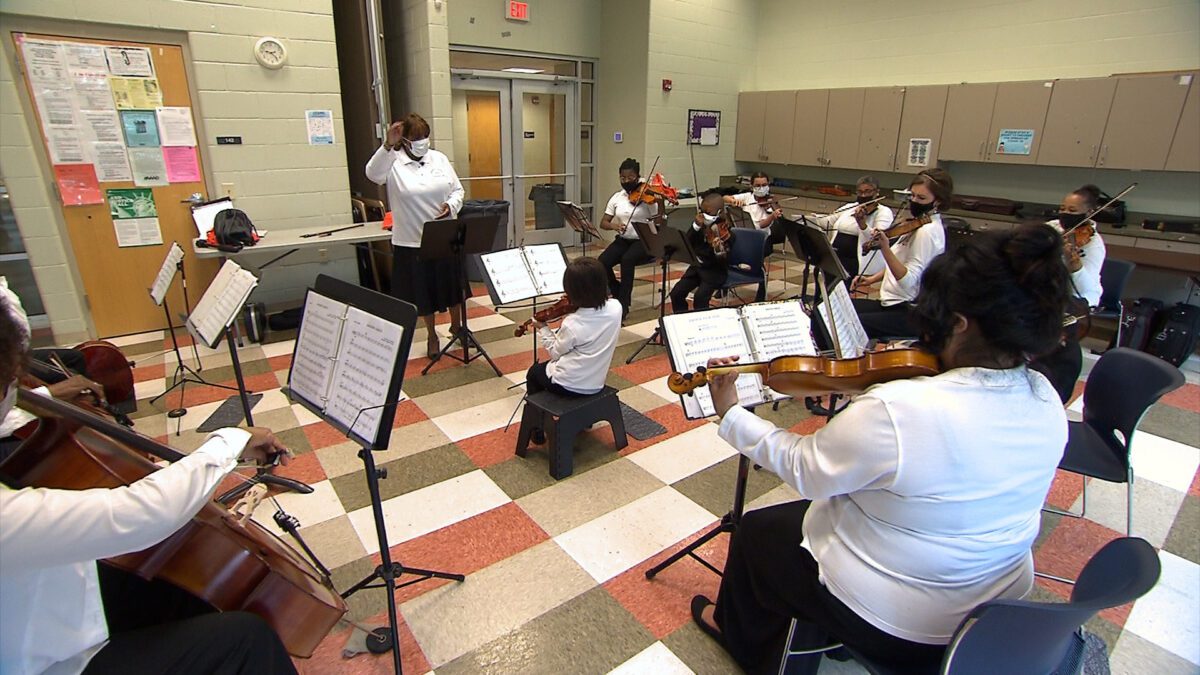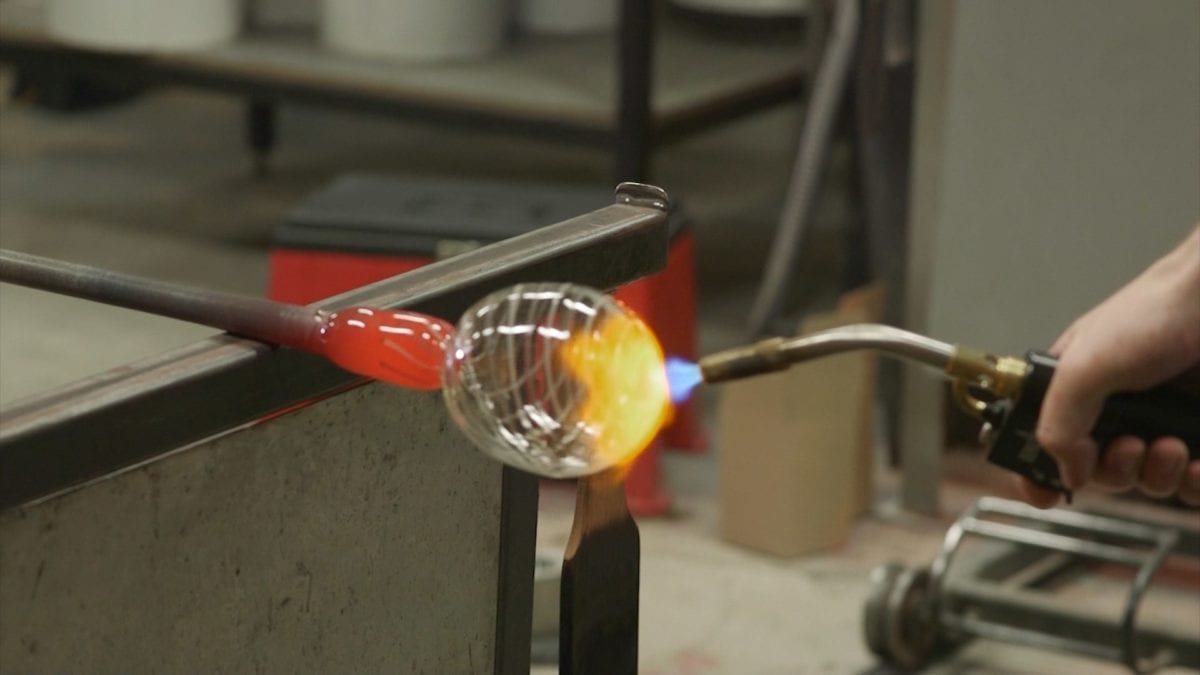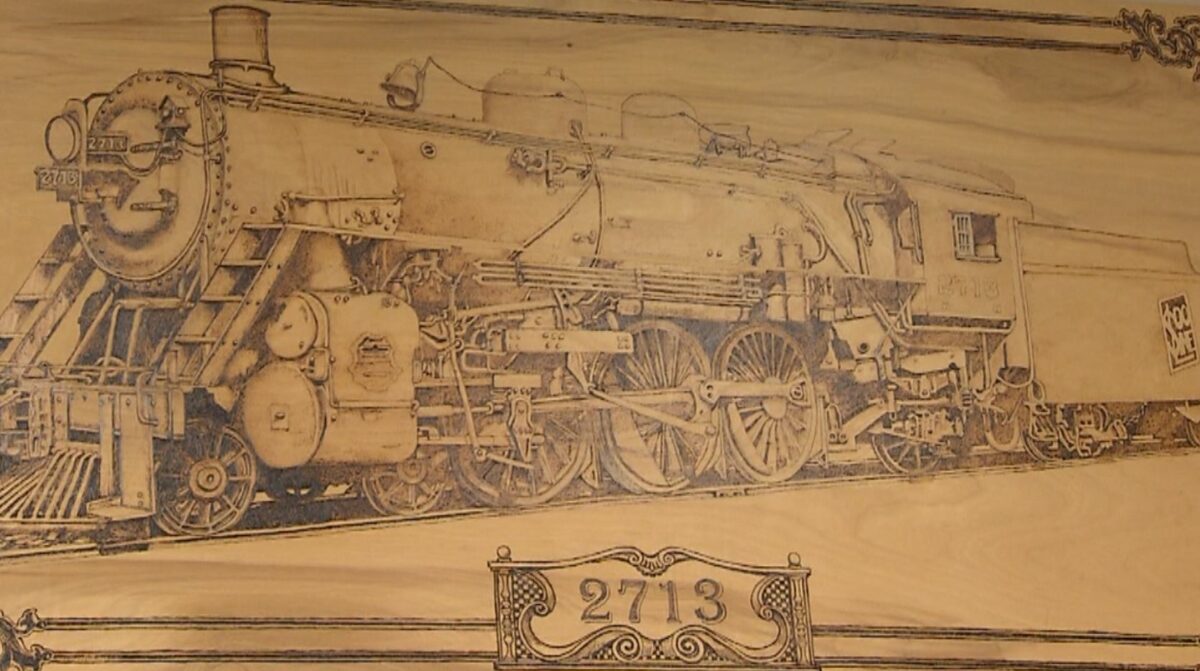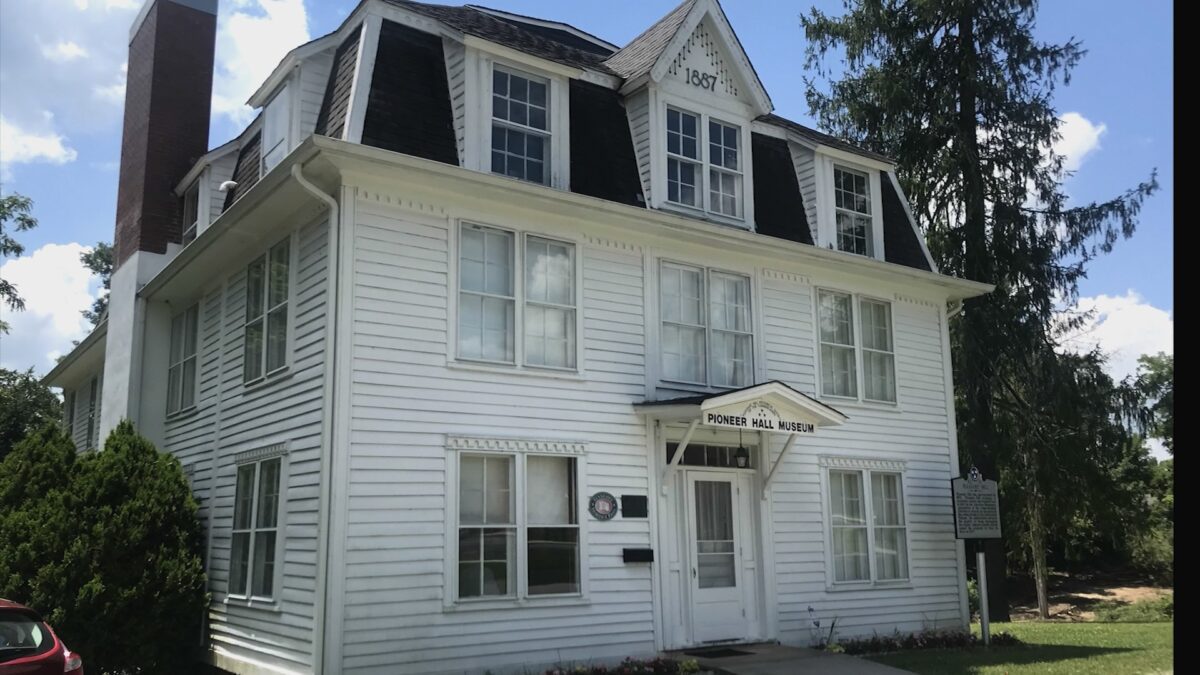Episode 3522
Don't have the PBS App? Click Here
Episode Transcript
- [Narrator] Tennessee Crossroads is made possible in part by... - [Advertiser] This season there's something small that makes a big difference. Flu vaccines, protect ourselves and others. Flu vaccines are available. Learn more at tn.gov/health/fightflu Taylor Farms provides farm fresh vegetables and fruits to grocery stores, schools, and hospitals, including vegetable kits, snack and veggie trays, and organic salads. More information @taylorfarms.com. - This time on Tennessee Crossroads, a moving musical story about a group called the Cremona Strings Ensemble. Then a history lesson about old time teaching in Pleasant Hill. We'll meet a smart, a computer geek who likes to burn paper and a Knoxville artist who likes to burn glass among other things. Hi, everybody, I'm Joe Elmore. Welcome again to Tennessee Crossroads. Our first story is an inspiring one. It's about a special musical program for children. It began back in the 60s in Nashville, and it continues to this day as Cindy Carter discovered. Here's the story of the Cremona Strings Ensemble. - [Cindy] It's Saturday morning and musicians young, and some a few years older, arrive at the Hadley Park Regional Community Center in Nashville. The hard work these very special artists do here is what makes their many performances across Middle Tennessee, noteworthy. - We can either bring more people into the field of music or create more music appreciation individuals. And that's important to me. - [Cindy] Lisa Spells is the founder and music director of the Cremona Strings Ensemble Too and Development Group. - One and a two and a three and a four. - [Cindy] The "Too" in the title is meant to separate these music makers from the original Cremona Strings Ensemble, which was founded in the 1960s by Nashville, African-American musician and teacher, Robert 'Bob' Holmes. - He went to the school board and asked if he could teach African-American children in segregated school system at that time to learn strings. And he was told, "Adamantly, no, black children do not have the aptitude to play strings." - [Cindy] Homes then went outside of the school system to bring together music and children, who otherwise wouldn't have the opportunity to try. - I am one of them original children, who started in the third grade, actually. - [Cindy] Today, Lisa carries on that musical mission with not only the children you see here, but their parents, as well. That's right, this nonprofit is designed for children four years and older, who don't have access or the opportunity to take string lessons, but the children accepted must also be accompanied by a parent or legal guardian who is also willing to learn. - But why would you ask what the adult have to also learn to play the instrument? So that they won't say to their child learning, "Oh, that sounds awful. Hurry up and learn how to do that. Get better, maybe that's not for you." - [Cindy] The setup may be a bit unorthodox, but Lisa says this type of side by side learning, and sharing, and playing is why the students who eventually move on, do so successfully. - But thank you, Joe. - [Cindy] Michael Brady, also joined the original Cremona Strings as a child, and is more than happy to serve as a mentor to this new generation. - To come again and to work with students with string instruments just gives me pleasure and I don't mind sharing what I've learned to keep the legacy going. - [Cindy] The strings in Cremona Strings are the viola, the violin, the cello, and bass. The instruments music and music stands are provided to the musicians at no cost. - We are a classical organization first, but we also do a little fiddling. Get that Tennessee flair. - Okay, Andrew, show me E Flat. All right, how about F Sharp? That's so great, I can learn so much from Andrew. And that's the point. This program builds skills that stretch far beyond any rehearsal space or performance space and benefits the entire community. - You learn how to have discipline. It transfers into your study habits, it transfer to your family construct, it transfers into combined organizational structures. - [Cindy] These disciplined artists also study music theory, music history, and composition. Violinist Nevada Bass understands, this is what it takes to make dreams come true. - Number one, assign for his music and composition. When I was in kindergarten, my class took a trip to the Nashville Symphony and I had told my mom while I was there, I wanted to be on that stage, playing one of the instruments. - [Cindy] And 11 year old, Andrew Calloway is grateful to Cremona Strings for getting him started on his musical journey. - Ms. Lisa asked me, "What instrument do you wanna play? Violin or viola?" And I was hesitant because I didn't know what they were, but my brother immediately said violin. So I took it upon myself to play the viola. - [Cindy] As school and community arts programs are eliminated or underfunded. This unique ensemble gently pushes back. - I love playing because it gives me joy. It gives me of a lot of feelings that I haven't felt before. - [Cindy] Audiences lucky enough to catch up Cremona Strings Ensemble Too performance, also feel that joy. And that's why those early Saturday morning rehearsals are worth every note. - Thanks, Cindy, we take public education for granted nowadays, but that wasn't the case back in the 1880s, thanks to the efforts of Northern Missionaries, Pleasant Hill Academy became one of the few educational bright spots in Tennessee. Ed Jones recently toured one of the school's original buildings, which now pays tribute to life and learning on the plateau 140 years ago. - [Ed] In the sleepy hamlet of Pleasant Hill, just across main street from the elementary school, stands Pioneer Hall, the last remnant of Pleasant Hill Academy. The first real school, this area ever had. - The American Missionary Association after the Civil War turned their attention to education of mountain children and American Indians. They established over 500 institutions. - I'm taking over here as a boy's dorm. This is made for two and one desk, and there was no closet because they didn't have that much clothes. There was some hangers on the back wall and that's basically all they had was their clothes that they hung up there. - [Ed] The only time students walk the creaky hardwood floors these days, is on field trips to learn about simpler times and a once grand educational institution built by a man on a mission. Sharon Weible is curator at Pioneer Hall museum? - The AMA sent the Reverend Benjamin Dodge, a congregational minister from New Hampshire to come to Pleasant Hill to establish a school and a church. He was known affectionately as Father Dodge. He came with his wife, Phoebe and his daughter, Emma, and they lived here for the rest of their lives. The first building that Father Dodge constructed, was the Academy building across the street from Pioneer Hall museum. The second building was this building Pioneer Hall, which opened as a dormitory in 1889, the school accepted boys and girls and any age, and many of the students who came were older than what we might think of as grade school and high school students. But it was their chance to get an education. - [Ed] And what an education it was. The AMA employed teachers from the finest schools across the country to share their knowledge with the children of the Cumberlands. - The Academy had an excellent reputation, academically. Students could go from the Academy to college at the University of Tennessee or to Berea College. They were very well-educated in a classical traditional education, but because of the work program, they also learned a life skills. - [Ed] Those life skills not only helped to better prepare the students with the future, but they were essential to keep Pleasant Hill Academy open. - They had a blacksmith shop and a lot of woodworking center. But all the stuff in here was handmade. - [Ed] Docent walks visitors through displays of items made and sold by the students to keep the Academy afloat. - The students did everything. They worked on the Academy farm, in the kitchen, in the dining room, in the garden. They rang the bell. - [Ed] You can't have a school without a bell, but this isn't just any old bell. - When Father Dodge came to Pleasant Hill and he depended heavily on benefactors. And one of those people was J.J. Gregory from Marblehead, Massachusetts, and Mr. Gregory purchased the Revere bell and he sent it to the academy. - [Ed] Revere, As in the Midnight Ride of Paul Revere? - The Paul Revere bell was cast by Paul Revere and sons in 1817. - [Ed] In addition to the revolutionary war hero, there's also a life-saving heroin in Pioneer Halls past. - Dr. May is a tremendous part of the story. - In 1917, when Edwin Wharton was appointed principal of Pleasant Hill Academy, he moved here with his wife and she was a physician. So she began treating students at the academy and people in the area. And when Edwin died in 1920, Dr. May decided to stay in Pleasant Hill and she and her friend, Elizabeth Fletcher, opened the first hospital here. - So Dr. May was way ahead of her time in treating tuberculosis. And one of the main things she did too, she went, she set up clinics all around in the area and traveled and she made house calls all the time, wherever she was needed, she went. - [Sharon] She was very influential in this region. Dr. May became known as Doctor of the Cumberlands. - [Ed] Pioneer Hall Museum holds much more than the memories of Pleasant Hill Academy. Upstairs you'll find a remarkable collection of items that made life on the plateau a little easier. - Some of you remember an ice box? - [Woman] Yeah. - All right. Here's an ice box. And as I remember, you'd hang in the window this sign each week, about how many pounds of ice you wanted. And then the ice man would cut the ice in his truck and bring it in and put it in the ice box. And of course it turned to water in about a week. - [Sharon] We move into an area upstairs that we call Life on the Cumberland Plateau. And that includes a kitchen and a general store and artifacts from the farm and the home. - [Ed] Artifacts that bring back memories for many visitors. - I'm loving it, all the antiques, the things that I see that I've used during my lifetime with my parents and grandparents. I don't want this history to be lost to our children. You need to know your history. You need to know your roots. - I hope that visitors take away a sense of the creativity and the courage and the hard work that was needed for people to flourish here. - By the way, the museum is only open on Wednesdays and Sundays. You know, the process of burning wood and paper to create works of art is ancient, but nowadays it's not that well known. Recently, we caught up with a wood-burning artist in Smyrna, who by day works in the high-tech world of information technology. Other times he pursues his passion to just burn things. - [Ed] Smyrna is home to one of four Motlow State Community College campuses. Here, modern technology is vital to teaching and learning. Why 25% of classrooms have a computer for each student. And increasingly online learning isn't a central component to the educational effort. That's where Terry Durham comes in. He's Dean of Motlow's academic technology. - If it's distance education, if it's distance learning, then my department's involved. - [Ed] A busy job with important responsibilities. So what does a guy like Terry do to unwind? - When I tell you I go home and burn things, I'm not kidding. I literally go home and burn things. - [Ed] Terry is a talented, dedicated, and very patient wood-burning artist. While today, he's creating a piece by burning paper, he's burned wood for the majority of his projects. - It started out like any 12 year old kid, got the wood-burning kit for Christmas and really fell in love with that. And then didn't revisit it again until probably 2001. I do a lot of horses, I do a lot of trains. I've done a lot of mills, especially in the eastern areas of this state. And I've also done a lot of the steam tractors or steam engines as we used to call them. My first step in the process is really to go and select that piece of wood. I've got a picture usually in mind, and then I have to go and find the piece of wood that that picture is gonna best fit. I used to come home and sand it, you know, a little bit more just to get it all the imperfections out that I can. And then I use tracing paper. Used to, I would outline the whole entire thing. And some of my first work, I called it line art because I did very little shading. The later projects, I've gone to almost all shading, so I will very lightly trace the major lines. And then the bulk of what I do is just shading from there. - [Ed] Imagine the time and patience that took to burn in each and every one of the bricks in this bridge, that's why it works like these attract lots of attention to craft shows, but not so many customers. - The projects that I'm doing now, really don't lend themselves to craft shows because those folks are looking for a relatively inexpensive product. And mine are a little bit more time-intensive, the train that you saw in my office that took six months. We went to the Meriwether Lewis Show down in Hohenwald and my wife was with me and a gentleman said, "I think you could do that with a laser." And I laughed and said, "Yes, but I don't have the 10 or $15,000 the laser would cost to do this. And plus that's not the reason I do it anyway." - [Ed] Terry has created a line of more affordable, smaller items, well, like these wooden trays. - I do more and more paper, it's a little easier, definitely to come by. It's easier to frame and hang rather than the wooden pieces. This is actually on 300 pound, cold pressed paper. So it's very thick. It's a real consistent surface. Somebody did ask me one time. They said, "Well, have you ever burned yourself?" Yeah, play with fire, you'll get burned, but I will say this, you only do it once. - [Ed] So while keeping thousands of students and instructors connected and supported in the name of higher education, his other passion is the more organic process of creatively burning paper and wood, and like a true teacher, he supports any budding artist who wants to learn to burn. - I'll have folks look at my stuff. And they'll say, "There's no way I could ever do that." Yes, there is, you can do it. If I can do it, you can do it. Actually believe it or not, the satisfaction I get is just trying to get better. - Our final story is about a national artists with two passions, which happened to compliment each other, one that starts hot glass blowing and one that ends cold craft brewery. Gretchen Bates has the whole pretentious story. - So you start with the furnace and that's about 2100 degrees. So you gather that up. Now it looks bright orange, but that's just because the intense heat that's crystal clear glass. - [Gretchen] Glass has been an important part of Matthew Cummings life for more than a decade, but not the most important, - Glass blowing brings me lots of joy, but not as much joy as my beautiful wife. She literally was getting on to me this morning 'cause I never mention her. - [Gretchen] Matthew is a study in contrasts. He owns Pretentious Glass and Beer Company, even though he's about as unpretentious as you can get. And while he spends his days turning molten sand into art. - I went to school to become an architect, trying to do something more response, you know, respectable. And then I had to take an elective and it was either ceramics or glass. And so I'd be grudgingly enrolled in glass. And that's what I've been doing ever since, which is a very active form of meditation. Like, you go in and you start blowing glass and then, but you don't think about Facebook. You don't think about all the problems, you're in the moment and you're just sinking up with that material. It's really old world. There is that apprenticeship system is still there. You can't read about it or watch videos about to learn how to do it. You have to get in, you have to put the time in, you have to sweat and with glass blowing, it's an honest material. You put the time in with your hands and you become good. - [Gretchen] "Good" doesn't begin to describe Matthew's talent. It goes far beyond glasses. - My background is actually sculpture. So when you come into Pretentious Glass down the Old City, we have everything you can possibly imagine, made out of glass. We have vases, we have pendants lights. We have sculptures, and then of course, all of the beer glasses that we're known for and the wine glasses and all the glassware. - [Gretchen] Those beer glasses, were actually the inspiration for the "Pretentious" name. Not that the name is pretentious, I mean, it is Pretentious. I'll let Matthew explain. - My friends, you know, we in vibed a little too heavily. And then that's either all the really good ideas start, or the really bad ideas start. I think we can say this was a pretty good one in hindsight. So one of my buddy was like, "Matthew, you should make us some beer glasses." I was like, "No!" I make sculpture, I don't make glassware. But I was like, "Will you buy it?" And they were like, "Yeah." So I made them the Tailored Hoppy glass, is the very first Pretentious Beer Glass. And you come in and you can actually get your hand print engraved into a glass. Like it fits like a glove and they just start giggling, all these grown men just giggling. And they're like, "This is so pretentious. We have our own tailored beer glasses for a bottle share club." And so whenever I decided to give that a try and see if craft beer glasses would stick, kept going back to that moment to come up with the name. - [Gretchen] That magic moment, which led to Pretentious Glass, could lead to magic for you as well. - We offer, "Make Your Own Workshops" every Friday and Saturday night. Those typically go from seven to nine. I would definitely recommend getting reservations. You get to design your own glass, beer, wine, water glass, or we do ornaments and flowers and pumpkins. You design it, and then you get to come in to the hot shop, learn about glass, and then also help us make it and do as much as you can possibly do in that time period so that we can still get something nice for you. - After your creative fires have pulled, pop in next door to wet your whistle with a work of art. - [Matthew] Craft beer it's a piece of art purchase upon a time. So that like lets us be able to share our passions with even more and more people. - [Gretchen] We've established Matthew's passion for beer and glass, they bring them him joy. - But not as much joy as my beautiful wife. - [Gretchen] Right, but Matthew surmised that combining his passion for glass and beer would increase said joy. Thus Pretentious Beer Company was born, which led to a pretentious number of beers. - We've made almost, hey, well, how many beers did we made, Alex? - or something. - Like 250 different beers. - [Gretchen] Which leads us, to the story of a man named Brady. - Will Brady, Brewer and maintenance supervisor. That's high, it's a good first run in there, yeah. It's probably gonna be like 17 1/2. I mean, I think we're always trying to one up ourselves, not anybody else with me, but always one up ourselves. They say that repetition may be the enemy of invention, but I don't believe that because we do a lot of repetition and just do minute tweaks. So a beer that's really good, we might've brewed that nine times to get it there. So from day one, it's always been very easy to just fall into this role where we can just sit around and have fun all day and then work kind of gets done. - [Gretchen] That the work will never be done, not as long as there's inspiration for a new beer or a custom glass to enhance its flavor. - We definitely use the craft beer as like a gateway to get people into and exposed to craft and exposed to art in Knoxville, where they come in for the beer and they're like, "Oh, you can go next door and watch glass bowling." And so many people have never seen glass bowling before and it's like, we wanna be the only place in the world where you can come in, drink beer made in house, out of glasses made in house, and watch everything being produced. The Tap Room is the brew house and the Glass Bowling Studio is all open concept. So on Friday and Saturday nights, you can come in, try some beers, walk next door, sit down, hang out, watch some glass bowling and literally watch them making beer glasses right in front of, it's pretty magical, it's fun. - Well, that just about winds up this week's visit. Hope you had a good time, hopefully you'll join us again and oh, by the way, check out our website, TennesseeCrossroads.org. Follow us on Facebook and I'll see you next time. - [Narrator] Tennessee Crossroads is made possible in part by... - [Advertiser] This season there's something small that makes a big difference. Flu vaccines, protect ourselves and others. Flu vaccines are available. Learn more at tn.gov/health/fightflu Taylor Farms provides farm fresh vegetables and fruits to grocery stores, schools and hospitals, including vegetable kits, snack, and veggie trays, and organic salads. More information @taylorfarms.com.
Tennessee Crossroads
January 06, 2022
Season 35 | Episode 22
Cindy Carter has the story of the Cremona Strings ensemble. Ed Jones tours the Pioneer Hall Museum. Joe Elmore meets wood burning artist Terry Durham. Gretchen Bates checks out a pretentious Knoxville business.




